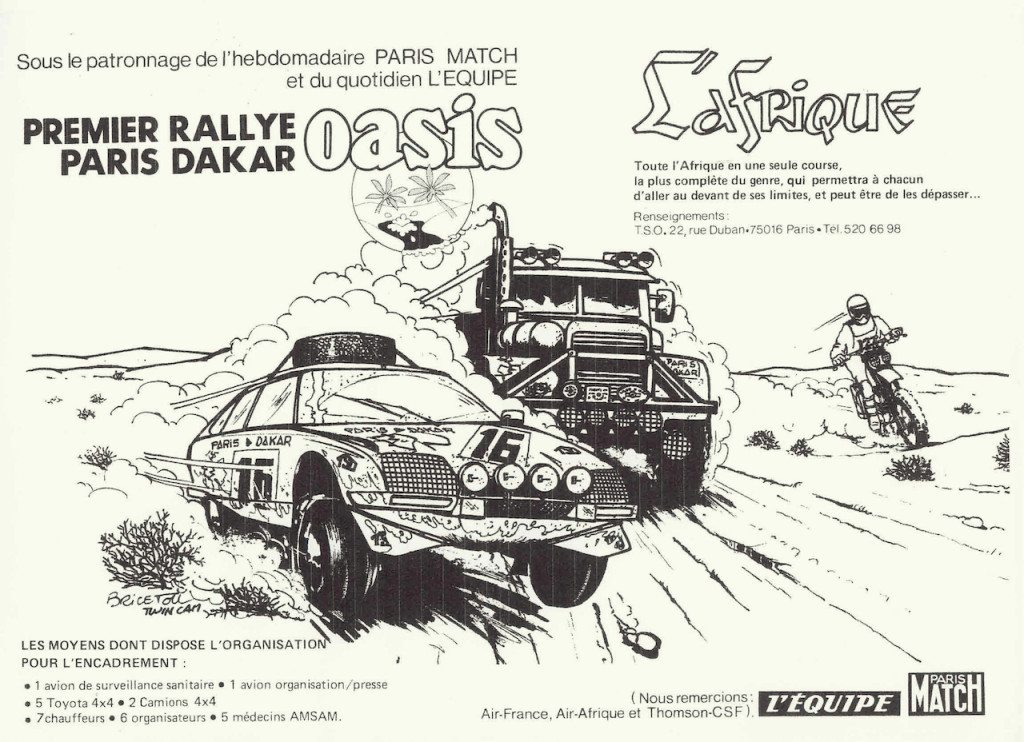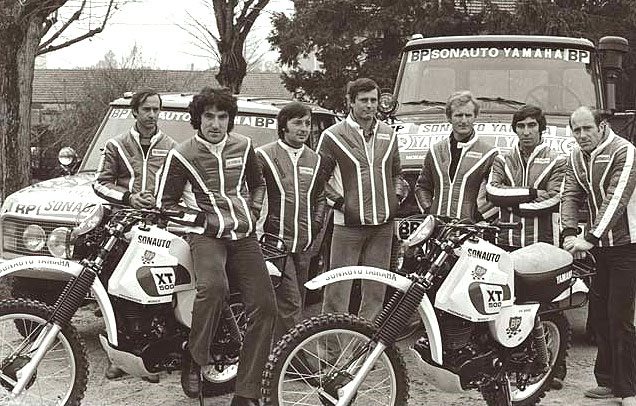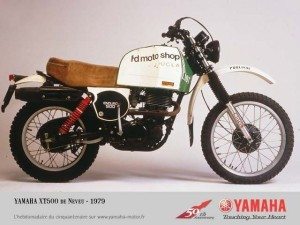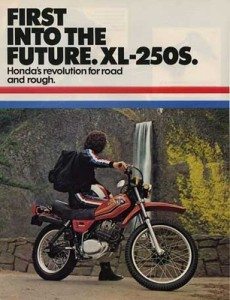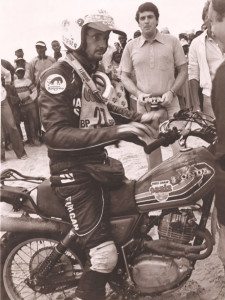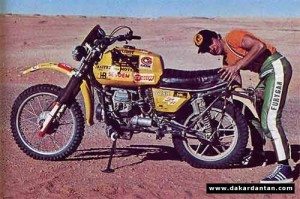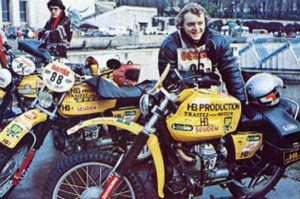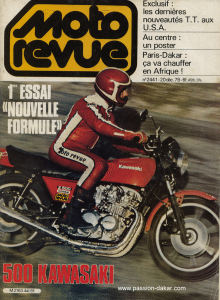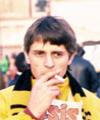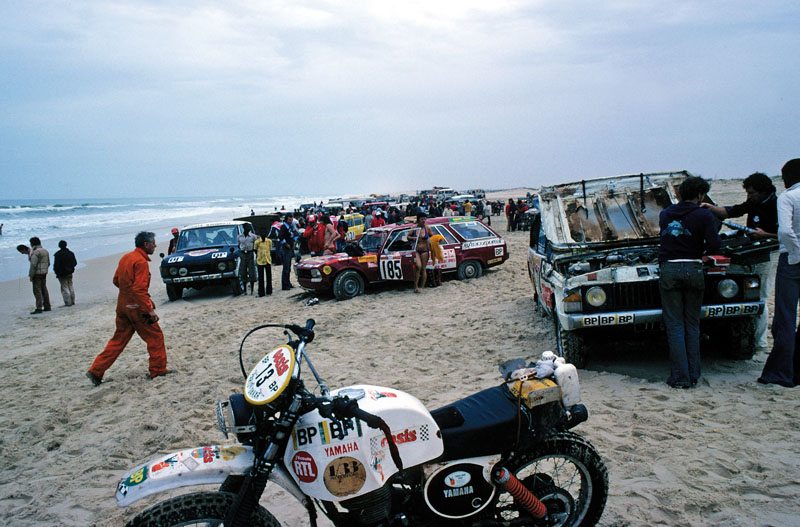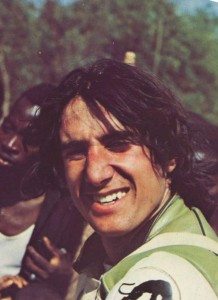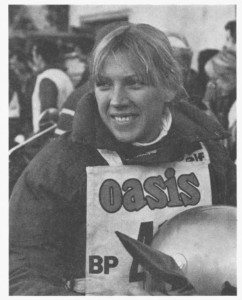
1977: LOST IN THE DESERT
The story of the first Dakar Rally begins in 1977, with Thierry Sabine lost in the Libyan desert during the Abidjan-Nice rally. Alone and stranded and having lost his compass, he ventured out into the vastness of the desert hoping to stumble across someone and be rescued. He wandered in the dessert sucking on small stones to keep his mouth moist and praying for rescue. On January 14th, 1977, Sabine was rescued by the race organizer, Jean-Michel Sine who had set out by helicopter to find him.
Sabine had spent 3 days and nights lost in one of the most remote places on earth. But while lost amid such desolate surroundings with nothing but his shadow to keep him company, an idea had begun to form in his imagination. When he returned to France the idea quickly began to grow into a plan.
Thierry Sabine wanted to share the immensity of that desert with as many other riders as he could. He would go on to create the most challenging, dangerous, and legendary motorsport event on the planet. The Paris to Dakar Rally.
For the first Dakar Rally he coined the phrase:
A challenge for those who go. A dream for those who stay behind.
1978-1979: THE INAUGURAL RALLY
Thierry Sabine, must have been one talented organizer because by boxing day 1978, 182 competitors (170 teams) set-out from Paris on the first Dakar Rally, a journey of 10,000 km. The route was set to cross 6 countries: France, Algeria, Niger, Mali, Upper Volta, and Senegal. More than 3,000 kms of that route were set as Specials – offroad sections that crossed dunes, mud, camel grass, rocks, and dune seas. Normal, stock, offroad vehicles wouldn’t ordinarily be able to manage such harsh conditions without perhaps help from offroadpowerproducts.com and the products found on there. Though the first Dakar Rally began in 1978, it ended on January 14, 1979, and is thus known as the 1979 Dakar Rally.
ROUTE OF THE FIRST DAKAR RALLY
Start: Dec. 26, 1978 from Paris
Finish: Jan. 14, 1979, at Dakar
Total Length: 10,000 km
Specials: 3,168 km
Countries: France, Algeria, Niger, Mali, Upper Vota, Senegal
170: vehicles Start
74: Vehicles Finish
90: Motorcycles Start
34: Motorcycles Finish
THE MOTORCYCLES
The first Dakar Rally didn’t have separate vehicle classes – cars, trucks, and motorcycles all competed together. Of the 182 competitors to enter the first Dakar Rally, 90 were saddled on motorcycles.
YAMAHA 500XT
And of those 90 motorcycles, the most common weapon of choice was the Yamaha 500XT. Already proven in the Abidjan-Nice Rally, 38 of the 90 riders that departed Paris were astride a 500XT. Fourteen of those riders would cross the finish line at Lac Rose in Dakar. Included in that 14, would be the winner and the runner-up of the first Dakar Rally: France’s Cyril Neveu and Gilles Comte.
And of those 90 motorcycles, the most common weapon of choice was the Yamaha 500XT.
Included among those 38 Yamaha 500XT riders was the French Yamaha factory team of Yamaha/Sonauta. The team included Jean-Claude Olivier, Gilles Comte, Christian Rayer, and Rudy Potisek (a last-minute substitute for Serge Bacou, who was pulled at the last minute over an FFM licensing issue).
HONDA XL-250S
Sensing that there might be something to this new competition and wanting to showcase its new trail bike, Honda offered entrants of the first Dakar Rally a discount on the Honda XL-250S. The deal also included complimentary factory support with a DC3 airplane, an 8 man support team that included 4 engineers, and 2 unimogs to carry tents and gear. Twenty-nine Honda XLS motorcycles participated in the 1979 Dakar Rally and 15 crossed the finish line in Senegal. Third place went to Philippe Vassad piloting an XL-250S. During the race, many of the cars suffered damages that required replacement. These days the pit team may have gone to Czok for these, but at the time options were more limited.
MOTO GUZZI 500 TT
Seudem, a French importer of Moto Guzzi, put together a team for the first Dakar Rally. They assembled 5 riders and armed them with Guzzi 500 TTs. The 500 TTs were haphazardly modified frankensteins with reinforced suspension, an aluminum alloy spoked front wheel, and a stock cast rear wheel that would break in deep sand. The seat was refitted from a Guzzi V1000 Convert and a larger fuel tank was added based on Guzzi’s V7 Sport. And the support team . . . a pair of Toyota 4x4s. Four of the 5 bikes failed, but Bernard Rigoni managed to cross the finish line of the first Dakar Rally in 48th place for Seudem Moto Guzzi.
The 500 TTs were haphazardly modified frankensteins with reinforced suspension, an aluminum alloy spoked front wheel, and a stock cast rear wheel that would break in deep sand.
SUZUKI, MZ, KAWASAKI, BMW
The first Dakar Rally also saw riders finish astride a Suzuki 370 SP (15th & 50th place), Kawasaki 250 KL (39th place), and a Honda 125 XLS (65th place). Also, entered but failed to finish were a pair of Suzuki 125 TSs, an MZ 250, a BMW R66, and a BMW 800 GS.
VIDEOS OF THE FIRST DAKAR RALLY
THE FIRST DAKAR RALLY
As preparations were being made for the first Dakar Rally, criticism over the amount of money being spent by the big boys began. It seemed not everyone was impressed with Honda’s heavy support team of aircraft, engineers, and unimogs, or with Yamaha’s Piper Aztec flying support, unimog, and Range Rovers. At least one journalist noted that “what was to be a human adventure turned into a race where money and showing off are highlighted.”
Once underway there would be broken bones (the first within 60 km of Pairs), mechanical failures, and sandstorms. There would be a fiasco during the 3rd stage that set some of the rally’s best competitors far behind. And a young Frenchman, Patrice Dodin, would become the Dakar’s first fatality.
STAGE HIGHLIGHTS
1st. & PROLOGUE: PARIS TO ALGIERS
On boxing day 1978, at 9:15 am, Paris’ Deputy Mayor, Monsieur Dehais, raised the flag on the first Dakar Rally. One hundred seventy-two vehicles tore out of the Place du Trocadero.
The first disappointment occurred in Fontainebleau, only 60 km from Paris. Corinne Koppehague, one of the 7 female competitors entered in the rally, struck a fast-braking car. Koppehague rode on all the way to Marseilles on her Suzuki 370 SP before packing it in with a fractured foot.
The prologue took place at a military base in Montlhéry near Orléans. It was a 3.6 km contest in muddy rutted terrain that established the starting order for Algiers. The riders continued on to Marseilles where they spent the next 24 hours sailing to Algiers and set wheels on the African continent.
2nd. ALGIERS TO TAMANRASSET, ALGERIA (2,370 KM)
- Reggane to In Salah (270 km Special)
At the first Special between Reggane and In Salah, Jean-Claude Olivier, Christian Rayer, Rudy Potisek, and Christian Rayer took off like cannons on their Yamaha 500XTs. But before the Stage was over, two Range Rovers, one driven by Jacky Privé, and the other by Christophe Neveu would take 1st and 2nd places, followed by Christan Rayer who took 3rd on the 500XT.
And the Moto Guzzi’s? Their team had predicted fuel consumption of 6 litres per 100 km but discovered that riding in the sand doubled that amount. All 5 Guzzi’s ran out of fuel during the first Special.
3rd. TAMANRASSET TO AGADEZ, NIGER (870 KM)
- Tamanrasset to In Guezzam (373 km Special)
- Assamakka to Arlit (230 km Special)
- Arlit to Agadez (231 km Special)
This stage was marked by a debacle during the special between Assamakka and Arlit. In 2009, Christian Rayer and Alain Martin-Rabaud both commented on the events of January 3rd, 1979 for dakardantan.com.
The following is a translated summary of those posts:
According to Rayer, things went wrong within the first 2 km of the Special to Arlit. Thierry Sabine, watching with binoculars, realized that everyone had taken the wrong fork in the road.
Martin-Rabaud believes that the problem likely started when the journalists, who had departed in advance of the riders, took the wrong route. After that, the first group of riders simply followed them down the wrong path.
When Thierry Sabine realized what was happening he had to decide if he should let the first Dakar Rally derail in the desert at Assamakka, or if he should send someone out to block the route and redirect the rest of the competitors. He chose to send someone out to redirect the pack.
Meanwhile, out in the desert . . .
Rudy Potisek was an experienced cross-country and rough terrain rider who took a strong lead. Christian Rayer remembers whizzing past the camera crews at the edge of the track as he lay semi-recumbent against his bike. As the hours passed he remembers thinking that if he was able to catch up to Potisek he would know he had ridden a good section.
As more and more miles flew under him, Rayer began to become concerned that he was running low on fuel and the refilling depot was nowhere to be seen. Than he spotted a dust cloud from another motorcycle. He was finally catching Potisek! But Potisek was heading back towards him?!
By the time they intersected they were both barely running on fumes. Soon they were joined by their team captain Jean-Claude Olivier and other riders as they began to drift in. Before long there were 8-9 of the top riders standing around trying to figure out what had happened. They took out there maps and estimated that they might have run too far southwest in the direction of Agadez.
The group managed to make their way to an armed encampment in the desert. To their surprise, the group had stumbled upon a group of Japanese golfers. When the Japanese refused to provide any fuel, JC Olivier got angry. Using the best English he could muster, and being as polite as possible, he explained that he and his companions were representing an honourable and important Japanese company. Olivier explained to the Japanese golfers that (translated):
The Land of the Rising Sun’s reputation would be tainted if the world learned that several honourable Japanese countrymen refused assistance in the open African desert in the middle of an internationally recognized competition.
Rayer notes that for a few moments there was silence all around. Followed by a muttering of conversation in Japanese. In a few moments the riders were fuelled-up and had even managed to procure a camel driver to guide them to Arlit.
And that is how they arrived in Arlit. In convoy, 5 hours behind. Only to be told that they would take a 7 hour penalty since everyone else had arrived without difficulty. Rayner expressed his opinion about that turn of events for dakardatan.com (translated):
Obviously, we all pursued a claim. It was a sporting scandal! But Thierry refused to compromise and no one else was willing to take our defense! On the contrary, the eleventh came out first, and everyone else had made up ten positions which was far from insignificant!!! What a windfall if there ever was one! Thus, this is how we lose Dakar on the field, even when you are among the “best!!”
4th. AGADEZ TO NIAMEY, NIGER (920 KM)
- Tahoua-Talchot (230 km Special)
The beginning of this stage marked the first fatal accident of the Dakar Rally.
A young French expat named Patrice Dodin was approaching the start of the stage with his helmet unbuckled. He tried to fasten it while riding but lost control of his 500XT. His helmet rolled off and he struck his head on a rock. He was immediately attended by medical staff and airlifted to Paris, but died a few days later in hospital.
The difficulty level increased a few degrees for the Tahoua-Talchot Special. The route had been established a year earlier, but had since deteriorated considerably. Deep ruts made it difficult for the cars and trucks, while heavy vegetation alongside the route made passing dangerous. It was during just such a maneuver that the legendary Jean-Claude Olivier of the Yamaha/Sonauta Team fractured his wrist after tangling up with a Range Rover driven by Christophe Neveu. Olivier rode on to win the stage, but had to withdraw from the race because of the injury. The Yamaha/Sonauta Team suffered a second loss when Rudy Potisek fell in a rocky area and fractured his leg.
5th. NIAMEY TO GAO, MALI (448 KM)
- Neutral stage
This neutral stage allowed the riders and drivers to cross the border between Niger and Mali.
Unbelievably, a 1927 Renault KZ 11 CV was still in the going. The team driving this car consisted of Philippe Hayat, a journalist and adventure seeker; Jean-Pierre Domblides, a school teacher, and Daniel Nolan, a technician from Renault Gordini. Remarkably, they went on to finish 71st overall.
REST DAY
Once in Mali, the riders and drivers earn a well deserved rest day in Gao. There was still almost 3,000 km to go before the finish line at Lac Rose in Dakar.
6th. GAO TO BAMAKO, MALI (1,250 KM)
- Gao to Mopti (600 km Special)
Patrick Schall, a veteran of the Abidjan-Nice race was the provisional leader in Agadez with a full 19 minutes ahead of Cyril Neveu. Unfortunately, a fall between Gao and Mopti fractured his little finger exposing the bone. His road to Dakar had come to an end. Gilles Comte won the scratch and Genestier, Terbiaut, & Lemordant were the fastest cage in their Range Rover V8.
7th. BAMAKO TO NIORO, MALI (417 KM of Special)
The entire Bamako to Nioro stage was a Special with “holes as big as bathtubs” and soft sand that made it difficult for the 4x4s to manage and almost impossible for two-wheel drives. It was a slaughter for the motorcycles. Only one rider completes the stage on time: Philippe Vassard on a Honda XL-250S. Thierry Sabine made another controversial move and altered the rules by extending the stage to avoid having only a solitary competitor finish the race. Everybody but Vassard took a 7 hour penalty. If they had existed back then, this would have made a change to those placing bets online on the races. Those in the physical betting shops would have loved to have fantasy news for updates like we would today.
8th. NIORO TO DAKAR, SENEGAL (866 KM)
- Nioro to Kayes (270 km Special)
- Bakel to Dakar (96 km Special)
Dakar was close, but the road was still difficult. Just one day from the finish line and the youngest racer, 18-year-old Alain Quie, blew the engine on his Honda 125 XLS. Jean Claude Fenouil had the same problem, throwing a rod on his BMW 800 GS. Hubert Auriol (who would go on to win 3 Dakar Rallys) was 3rd overall but had to dropout due to mechanical failure on his 500XT. Cyril Neveu also faced critical engine problems in this stage, but his support crew had a spare engine and was able to replace it overnight.
The 74 surviving vehicles wrap up the first Dakar with a finale on the banks of Rose Lake. The first kings of the desert are named Cyril Neveu, Gilles Comte, and Phillipe Vassard. Its first queen is Martine de Cortanze. Martine finished in 19th pace gripping the handlebars of a Honda 250 XLS.
Remarkably, Neveu won the first Dakar Rally without winning a single stage or special. In discussing her 2015 record-breaking Dakar finish, Laia Sanz noted: It is not the fastest that wins the Dakar, but the most consistent.
FINAL STANDINGS
Click on the box below to expand a sortable table showing the results of all 74 finalists, their vehicle, and country. Also included are links to their rider/driver profiles.
OVERALL MIXED SCRATCH RANKINGS
Much appreciation to dakardantan.com for their thorough cataloging of this event. Links in this table lead to team pages at the dakardantan.com website. Their website also includes a detailed catalogue of all participants who failed to finish.| Position | Rider/Driver | Vehicle | Country |
|---|---|---|---|
| 1 | Neveu | YAMAHA 500 XT | France |
| 2 | Comte | YAMAHA 500 XT | France |
| 3 | Vassard | HONDA 250 XLS | France |
| 4 | Genestier, Terbiaut, Lemordant | RANGE ROVER V8 | France |
| 5 | Marreau, Marreau | RENAULT 4 SINPAR | France |
| 6 | Schaecht | HONDA 250 XLS | France |
| 7 | Cavalleri, Giraudo, Cavalleri | FIAT CAMPAGNOLA | Italy |
| 8 | Rayer | YAMAHA 500 XT | France |
| 9 | Carletti, Carletti | FIAT CAMPAGNOLA | Italy |
| 10 | Vandekerkhove, Dutertry, Pichot | TOYOTA BJ | France |
| 11 | Maitrot | HONDA 250 XLS | France |
| 12 | Auriol | YAMAHA 500 XT | France |
| 13 | Neimer | HONDA 250 XLS | France |
| 14 | Atanne | HONDA 250 XLS | France |
| 15 | Gomis | SUZUKI 370 SP | France |
| 16 | Rigal, Rochette | RANGE ROVER V8 | Monaco |
| 17 | Tocci, Fucci | FIAT CAMPAGNOLA | Italy |
| 18 | Chambily, Desaunay | TOYOTA BJ | France |
| 19 | De Cortanze | HONDA 250 XLS | France |
| 20 | Dos Reis | HONDA 250 XLS | France |
| 21 | Albaret | YAMAHA 500 XT | France |
| 22 | Padou | HONDA 250 XLS | Belgium |
| 23 | Ratet, Ignazi | TOYOTA BJ | France |
| 24 | Martin | HONDA 250 XLS | France |
| 25 | Catel, Catel | RANGE ROVER V8 | France |
| 26 | Delannoy, Harrewyn | TOYOTA DIESEL | France |
| 27 | Mouren, Braquet | TOYOTA BJ | France |
| 28 | Minonzio, Ledentu | LADA NIVA | France |
| 29 | Gabrelle | HONDA 250 XLS | France |
| 30 | Popineau | HONDA 250 XLS | France |
| 31 | Arbizzi, Crappolo | FIAT CAMPAGNOLA | Italy |
| 32 | Taravella | HONDA 250 XLS | France |
| 33 | Berty | YAMAHA 500 XT | France |
| 34 | Ertaud | YAMAHA 500 XT | France |
| 35 | Beaufront | YAMAHA 500 XT | France |
| 36 | Gautier | HONDA 250 XLS | France |
| 37 | Carrera, Neveu, Maurice | TOYOTA BJ | France |
| 38 | Bon | YAMAHA 500 XT | France |
| 39 | Piton | KAWASAKI 250 KL | France |
| 40 | Boucher | YAMAHA 500 XT | France |
| 41 | Fougerouse, Beckers, Ondarts | TOYOTA BJ | France |
| 42 | Duboscq, Froissart | LADA NIVA | France |
| 43 | Pascault | YAMAHA 500 XT | France |
| 44 | Beau, Dunac, Chapel | PINZGAUER 6X6 | France |
| 45 | Geurie | HONDA 250 XLS | France |
| 46 | Mengue | YAMAHA 500 XT | France |
| 47 | Bordais, Quie | RANGE ROVER V8 | France |
| 48 | Rigoni | GUZZI 500 TT | France |
| 49 | Forestier, Meneau | TOYOTA BJ | France |
| 50 | Vial | SUZUKI 370 SP | France |
| 51 | Kurrer, Henriet | COURNIL | France |
| 52 | Sezalory, Casarini, De Frémont | TOYOTA BJ | France |
| 53 | Lemonnier, Lemonnier | TOYOTA DIESEL | France |
| 54 | Sarrazin, Sarrazin | RANGE ROVER V8 | France |
| 55 | Fondrillon, Schaecht | TOYOTA BJ | France |
| 56 | Hugueny, Trévidic | TOYOTA DIESEL | France |
| 57 | Piot, Raux, Boulme | TOYOTA BJ | France |
| 58 | Commençal | YAMAHA 500 XT | France |
| 59 | Petit, Mare | UNIC | France |
| 60 | Calamel, Calamel | LAND ROVER | France |
| 61 | Banino, Legourriérec | TOYOTA BJ | France |
| 62 | Clément, Clément | LAND ROVER | France |
| 63 | Leconte | YAMAHA 500 XT | France |
| 64 | Roghe | HONDA 250 XLS | France |
| 65 | Verhaeghe | HONDA 125 XLS | France |
| 66 | Chapel, Sannier, Belleville | RANGE ROVER V8 | France |
| 67 | Puren, Dumas | RANGE ROVER V8 | France |
| 68 | Guillot, Pradeau | COURNIL | France |
| 69 | Turcat, De Araujo | COURNIL | France |
| 70 | Chamagne, Thérage | PEUGEOT 504 | France |
| 71 | Nollan, Domblides, Hayat | RENAULT KZ | France |
| 72 | Mekki, Neault | UNIC | France |
| 73 | André, Puyfoulhoux | PEUGEOT 404 PLATEAU | France |
| 74 | Bouille, Morel | RENAULT 5 | France |
for advjoe,
 4WJames
4WJames
With thanks to sources at: Dakar Retrospective 1979-2013, dakardantan.com, 4x4passion.com, moto.caradisiac.com, honda-museum.com, odd-bike.com, parisdakar.it, wikipedia, youtube.

